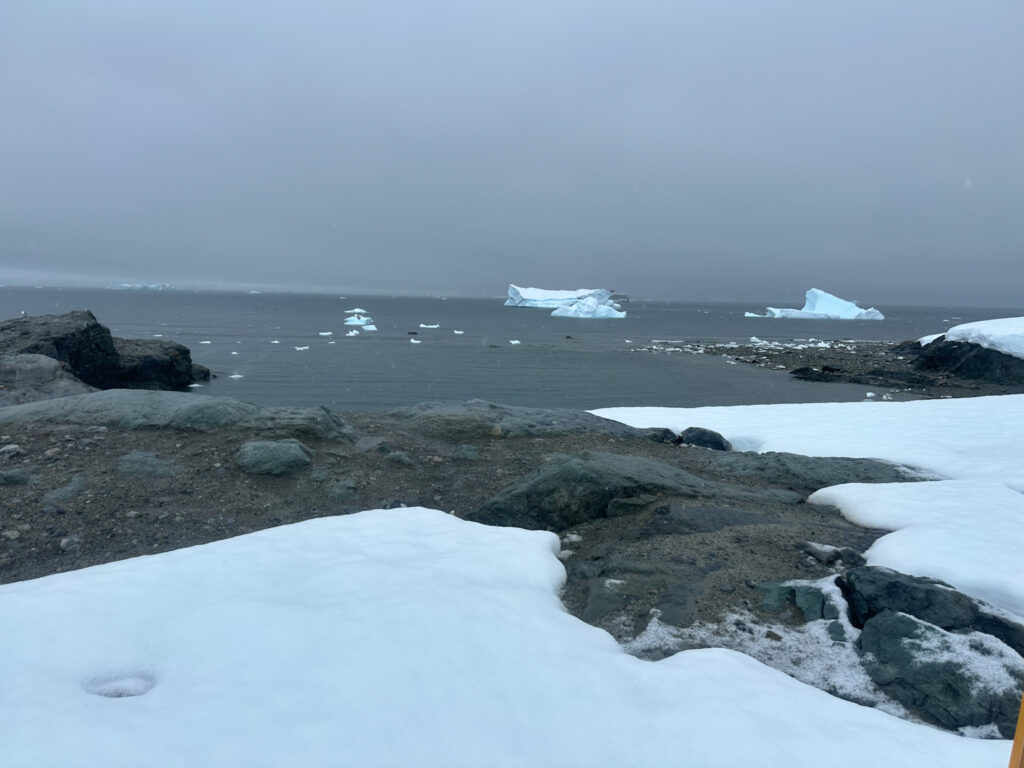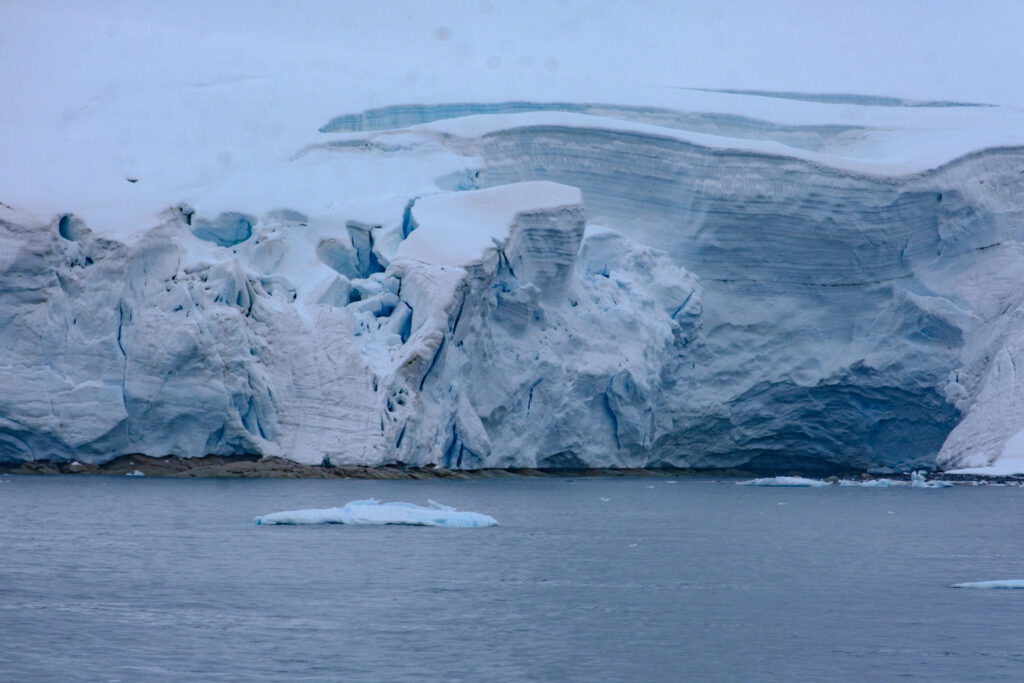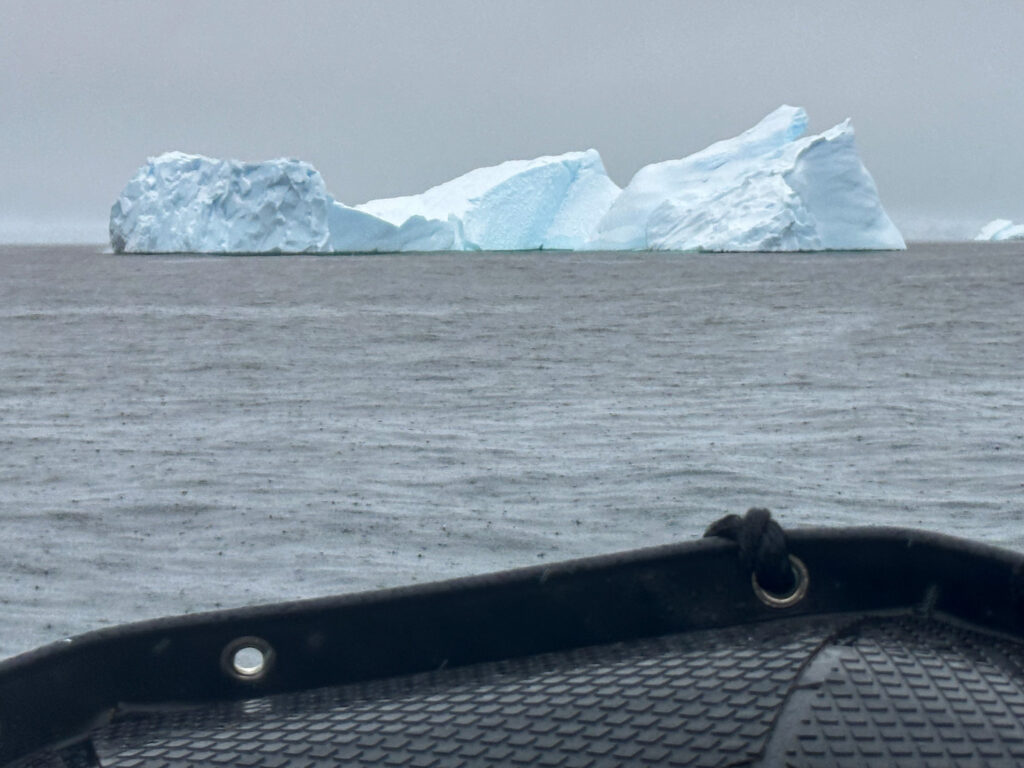So today’s the day – feet on the actual continent of Antarctica. Big woop. We’re on the tip of the Antarctica peninsula that stretches out toward South America the way a child’s hand reaches toward Mama when she drifts away.
A few hundred million years ago (experts seem to disagree on the exact date), the continent called Gondwana consisted, more or less, of Africa, South America, Australia and Antarctica. Plate tectonic action being what it is, all those continents agreed to go their separate ways. The last division was when Antarctica and South America split, maybe 40 million years ago. Today the Drake Passage spans the distance between the two.
Bottom line: sure, we’ve been to continental Antarctic, and I’m happy for it. But to say we’ve seen Antarctica is like saying you’ve seen the United States after visiting Miami.
While we waited for our trip, we were able to observe humpback whales having breakfast all around the ship. Must be a fertile feeding ground.
Our zodiac left at 11:00 AM in a steady rain. Temps in the mid 30s again. Visibility low in fog and the rain. Half way there (a 20 minute ride, perhaps) we encountered a vast field of ice. There were the usual large ice bergs, of course. But these were chunks of ice ranging from stone size to maybe three or four feet in diameter. Our driver had to slow down and pick his way through the field.
The ice field was caused by a nearby glacier that was actively calving new icebergs. While we were on land there were three or four such calving events. No warning, of course but there was a loud boom and roaring splash sound. A few minutes later waves would wash up on the shore where we were, maybe a half mile away. I wasn’t quick enough to catch the aftermath of one the calving events like I did 15 years ago in Alaska. The old boy is slowing down, I guess.
No wildlife except a Kelp gull or two. But the views, as always, were fantastic. The rain and low visibility added to the mystery of the scene.
Back on board and after a shower to warm up we had lunch and got to fretting. We’ve been bugging the expedition staff because we wanted another trip off the ship. There were several SOB (Special Operation Boat) trips for the afternoon, all booked full. Finally, one staff member suggested we go fully dressed and prepared to go to fill in any last minute no-shows. We did so and sure enough we made a boat that left just before 3 PM.
That makes us sound pretty savvy, right? Not quite. I realized maybe half-way to the boarding area that I didn’t have my key card – left it in the stateroom. Ran halfway back in full regalia and realized without a key I couldn’t get my key. Back to Judy in the boarding area. Back to the room. Back to the boarding area. “Jon, we need our Quiet Boxes so we can hear the guide.” Back to the room. Back to the boarding area. “Quick, follow me!” Demanded the boarding agent. Each trip was maybe half the length of the boat. Good news: my watch says I achieved my exercise goal for the day!
But what a great trip it was. To start, we motored out from the ship maybe half an hour. Our goal was to find the humpback whales that were feeding in the area. Earlier trips had had great success. But all we saw was icebergs. No whales.
But that wasn’t all bad. Icebergs have a definite personality. Some resemble animals or people. Some resemble massive edifices. Some are works of art with swirls and angles that please the eye or challenge one with disquieting shapes. White and blue are the dominant colors, with a black spot or two if the berg took along some rocks when it calved. It’s sort of like laying in a hammock watching clouds pass by, imagining what each cloud might represent. Who cares about whales? See one, you’ve seen ‘em all. Not so with clouds. The weather had switched from rain to snow, making the experience even more surreal,
On the way back, maybe 10 minutes from the ship, sure enough we saw one, then two, then three whales putting on a show less than 100 yards from our SOB. One was a young calf, probably learning how to swim and feed with its mom. The object of the game for the whales was to dive down, pushing its tail in the air to get better diving speed and to put on a show for the tourists. Once down, they’d take on a big mouthful of krill. Krill resemble a shrimp (but they’re not), maybe two to three inches long in these parts. So it takes a pretty big mouthful to feed a 40-ton humpback. Sure they’ve gotta eat, but you can’t convince me that those whales aren’t having a whale of a time doing all that fancy swimming and diving.
Back on board, we went through our second de-robing of the day, chilled until 5:30 and went to the all important daily briefing. On other cruise trips, the tour director tells you about tomorrow’s port, where to meet the bus to go see the cathedral, where to buy trinkets, and so on. On this trip, it’s something entirely different.
Right now, we, and 12 other expedition ships, are cruising in the lee of the Antarctic Peninsula, the eastern side. Between us and South Georgia Island, the Falkland’s, Ushuaia, just about anywhere, there’s a pretty big low pressure area. Winds forecast to be 57 knots. None of the ships want to subject their paying passengers to that. It looks really bad on Trip Advisor if everyone writes in with barfing stories. Thupshot is that we’re going to wander around the peninsula tomorrow, maybe going to a place where Orca whales might be seen, but who knows. Then, assuming the storm starts to move on, we’ll head for the Orkney Islands, halfway between here and South Georgia. Viking has never been there but, hey, it’s a destination that hopefully gives the storm more time to move on.
The expedition staff keeps telling us that this is what we all signed up for: an expedition. And expeditions are all about uncertainty. Viking and the other ships have all the technology to keep us safe so this isn’t like Amundsen, Scott and Shackleton adventuring. Judy and I have decided we really like this kind of travel.
We had dinner in the Italian restaurant called Manfredi’s. It’s exactly the same as the Manfredi’s on the Orion when we sailed Australia several years ago. Wait, that was last November? Time flies.
The final event of the evening was the launching of a weather balloon. The data from our ballon is fed to NOAA. Balloons all over the world are launched twice a day at the exact same time to give NOAA data about worldwide weather conditions.



























































A true adventure!!!
Thanks Diane. An adventure it is